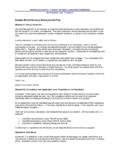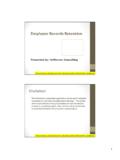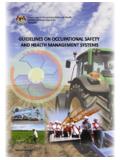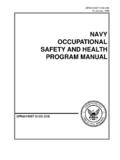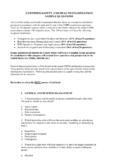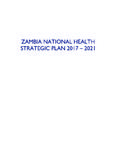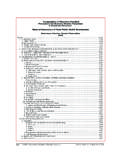Transcription of Sample Safety and Health Program for Small Business ...
1 WORKPLACE Safety : A GUIDE FOR Small & MID-SIZED COMPANIES By Hopwood and Thompson Sample Safety and Health Program for Small Business This Sample Program follows the occupational Safety and Health administration s (OSHA) " Safety and Health Program Management Guidelines. These guidelines were drawn from the experience obtained enforcing the OSHA Act, from the Voluntary Protection programs (VPP), OSHA programs to recognize excellence in worksite Safety and Health , from OSHA s Consultation Program , and from public commentary. This Sample Program is especially written for the Small , independent Business owner, but the outline can be applied to any size Business . WORKSITE GOODFELLOW S Safety AND Health Program Management Leadership and Employee Involvement Management commits the necessary resources of staff, money, and time to ensure that all persons on the worksite are protected from injury and illness hazards. In addition, management visibly leads in the design, implementation, and continuous improvement of the site s Safety and Health activities.
2 Specifically, the highest level management establishes and reviews annually the site s Safety and Health policy and ensures that all employees know, understand, and support that policy. All management levels, with input from hourly employees, develop an annual Safety and Health goal with objectives and action plans to reach that goal. At the end of each year all management levels, with input from hourly employees, evaluate progress in accomplishing the action plans, achieving all objectives, and meeting the annual goal. This evaluation, which also includes an evaluation of the overall Safety and Health Program , results in a written report that includes the next year s goal, objectives, and action plans, including any remaining action needed to accomplish the current year s goal. Management ensures that all employees, including themselves, have clearly written Safety and Health responsibilities included within their job description, with appropriate authority to carry out those responsibilities.
3 Also, management ensures that all employees, including all levels of management, receive performance evaluations that include a written evaluation of the accomplishment of assigned Safety and Health responsibilities. Management ensures that all visitors to the site, including contract and temporary labor, co-op students, interns, vendors, and sales people, have knowledge of site hazards applicable to them and how to protect themselves against those hazards, including emergency alarms and procedures. Management also ensures that these visitors do not introduce to the site hazards that can be prevented or that are not properly controlled. Management ensures that at least several avenues exist for employee involvement in Safety and Health decision making and problem solving. These avenues may include serving on committees and ad hoc problem solving groups, acting as Safety observers, assisting in training other employees, analyzing hazards inherent in site jobs and how to protect against those hazards (writing JHAs), and planning activities to heighten Safety and Health awareness.
4 Management encourages employees involvement and devises appropriate recognition for outstanding employee participation. Suggested documents to implement this element. Worksite policy (note how this policy is communicated to the work force and visitors); Current year s goals, objectives, action plans, and Program evaluation; Job descriptions that include Safety and Health responsibilities; Performance evaluations that include an evaluation of Safety and Health responsibilities; Budget showing money allocated to Safety and Health ; Contractor bidding proposal sheets showing all contractors prior Safety and Health record; Orientation outline for all site visitors, including contractors; WORKPLACE Safety : A GUIDE FOR Small & MID-SIZED COMPANIES By Hopwood and Thompson Evidence of employee involvement, such as committee minutes or other records of employee participation in Safety and Health Program decisions. Worksite Analysis Management hires outside consultants as necessary to conduct baseline surveys that identify all Safety and Health hazards at the site at the time of the survey.
5 All hazards found during these surveys are eliminated whenever possible or controlled. All employees who may encounter the controlled hazards are trained in appropriate job procedures to follow to protect themselves from these hazards. Management establishes change procedures to follow whenever the site experiences changes in equipment, material, or processes. To ensure employee protection, these change procedures include consideration of Safety and Health in the selection of the change, equipment and process shut down procedures, start up procedures, and phase hazard analysis. Appropriate employees are trained to follow these procedures. Management and employees work together to analyze Safety and Health hazards inherent in each job site and to find means to eliminate those hazards whenever possible, and otherwise to protect persons against those hazards. These job hazard analyses (JHAs) are revised as appropriate, for example, following a change in the job, the reappearance of a hazard, or an accident at this job.
6 All employees at this site are trained to recognize hazards and to report any hazard they find to the appropriate person so that the hazard can be corrected as soon as possible. In addition to taking immediate action to report a hazard orally and to provide interim protection, if necessary, including stopping the work causing the hazard, employees may submit a Safety work order to the maintenance department, or they may submit a Safety suggestion form. Safety work orders take priority over any other work order. Safety suggestions will be considered each week during the site inspection by the site inspection team. All employee reports of hazards must be eventually written, with the correction date recorded. These reports are posted in the lunch room until the hazard is corrected and then are kept on file in the owner s office for three years. During that time they are available for employee review. Site management, with input from an hourly employee chosen by lot, organizes the monthly site inspection team.
7 Membership on these teams rotates each month with the goal that all site employees serve one month each year. Teams consist of four people, two managers or supervisors and two hourly employees. Each week, at the beginning of work on Wednesday morning, the team inspects the entire worksite, in writing describing all hazards found, including their location. The team assigns appropriate persons responsible for seeing that the hazard is corrected and documenting the date of the correction. These inspection reports are posted in the lunch room, in the maintenance shop, and in the owner s office. A hazard remains on the monthly report until it is corrected. Any near miss, first aid incident, or accident is investigated by the trained team selected each year by the owner and an hourly employee. The team consists of two managers or supervisors and two hourly employees, each of whom has received training in accident investigation. All investigations have as a goal the identification of the root cause of the accident, rather than assigning blame.
8 All accident reports are posted in the lunch room and are open to comment by any employee. The accident investigation team assigns responsibility to appropriate employees for correcting any hazards found and for assigning a date by which the correction must be completed. As part of the annual Safety and Health Program evaluation, the site owner, a manager, and an hourly employee review all near misses, first aid incidents, and entries on the OSHA 200 Log, as well as employee reports of hazards, to determine if any pattern exists that can be addressed. The results of this analysis are considered in setting the goal, objectives, and action plans for the next year. Suggested documents to implement this element. Results of baseline Safety and Health surveys, with notation of hazard correction; WORKPLACE Safety : A GUIDE FOR Small & MID-SIZED COMPANIES By Hopwood and Thompson Forms used for change analyses, including Safety and Health considerations in the purchase of new equipment, chemical, or materials; JHAs; Employee reports of hazards; Site Safety and Health inspection results, with hazard corrections noted; Accident investigation reports, with hazard corrections noted; Trend analyses results.
9 Hazard Prevention and Control Management ensures that the this priority is followed to protect persons at this site: (1) Hazards will be eliminated when economically feasible, such as replacing a more hazardous chemical with a less hazardous one; (2) Barriers will protect persons from the hazard, such as machine guards and personal protective equipment (PPE); (3) Exposure to hazards will be controlled through administrative procedures, such as more frequent breaks and job rotation. Management ensures that the worksite and all machinery is cared for properly so that the environment remains safe and healthy. If maintenance needs exceed the capability of the worksite employees, contract employees are hired to do the work and are screened and supervised to ensure they work according to the site s Safety and Health procedures. All employees, including all levels of management, are held accountable for obeying site Safety and Health rules. The following four step disciplinary policy will be applied to everyone by the appropriate level of supervisor: oral warning; written reprimand; three day s away from work; dismissal.
10 Visitors, including contractors who violate Safety and Health rules and procedures, will be escorted from the site. Should the disciplined person request a review of the disciplinary action, an ad hoc committee of six people, three managers and three hourly workers, chosen by their respective colleagues, will review the situation and make a recommendation to the owner, who reserves the right for final decision. If his decision differs from the committee, he may, within confidentially strictures, make public his reasons. The site works with appropriate outside agencies, such as the fire department, the police department, and the hospital to write emergency plans for all potential emergencies, including fire, explosion, accident, sever weather, loss of power and/or water, and violence from an outside source. Desk top drills are conducted monthly so that all employees experience a drill on each type of emergency once a year. A total site evacuation drill focusing on one emergency type, with all work shut down, and coordinated with the appropriate agency, is conducted once a year.

